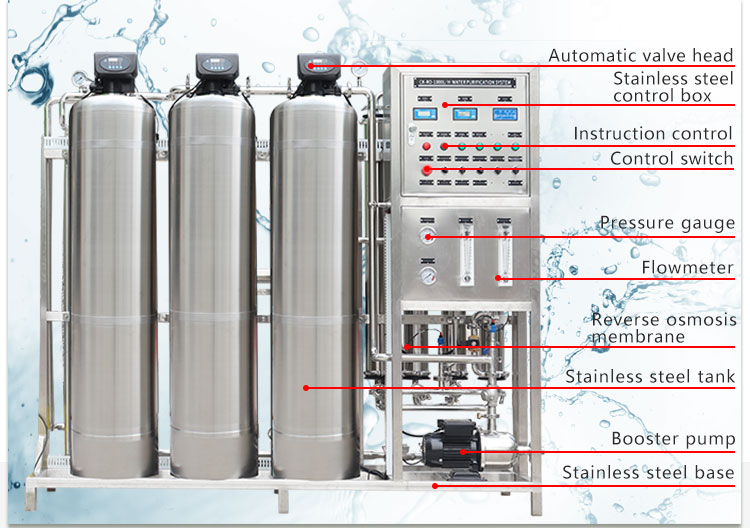Which whole-house water filtration system can remove the most pollutants?
In today's society where water pollution is becoming increasingly serious, whole-house water filtration systems have gradually become an important choice for families to ensure water safety. Choosing a suitable whole-house water filtration system can effectively remove a variety of pollutants in the water and ensure the health of the water used by the whole family. However, among the many water filtration systems, which system can remove the most pollutants? This article will explore this issue in detail.

What are the types of whole-house water filtration systems?
Before choosing a whole-house water filtration system, you first need to understand the different types of systems. Whole-house water filtration systems can be roughly divided into the following categories:
1. Sediment Filters:
2. Activated Carbon Filters:
3. Ion Exchange Systems:
4. Reverse Osmosis Systems:
5. UV Purification Systems:
6. Whole-House Comprehensive Filtration Systems:
1. Sediment Filters:
This system mainly removes large particles such as sand, rust and soil from the water through physical filtration. Although this system can effectively remove suspended particles, it has limited removal capacity for dissolved pollutants, chemicals or microorganisms.
2. Activated Carbon Filters:
Activated carbon filtration systems are widely used in water treatment. They mainly remove chlorine, organic compounds, odors, colors and some heavy metals from water through adsorption. The pore structure of activated carbon can effectively capture small molecular organic matter, but the removal effect of bacteria, viruses and inorganic salts is limited.
3. Ion Exchange Systems:
This system is mainly used to soften water quality, remove calcium and magnesium ions in water through ion exchange resins, and reduce scale formation. Although the ion exchange system has a significant effect on hard water treatment, it is not able to remove other organic pollutants and chemical pollutants.
4. Reverse Osmosis Systems:
The reverse osmosis system is one of the most efficient water filtration technologies currently available. It removes most soluble pollutants in water, including heavy metals, bacteria, viruses, pesticide residues, etc. through the selective permeation of a semipermeable membrane. The reverse osmosis system can remove up to 95% of pollutants, but it will also filter out minerals that are beneficial to the human body.
5. UV Purification Systems:
The UV disinfection system destroys the DNA structure of microorganisms through ultraviolet radiation to achieve the effect of sterilization and disinfection. This system is mainly used to kill bacteria, viruses and parasites in water, and has no ability to remove chemical pollutants.
6. Whole-House Comprehensive Filtration Systems:
Whole-House Comprehensive Filtration Systems combine multiple filtration technologies, integrating sediment filtration, activated carbon filtration, ion exchange and reverse osmosis. This system can fully treat various pollutants in the water and is the most comprehensive type of system with removal capabilities.

How to evaluate the removal capacity of a whole-house water filtration system?
To evaluate the ability of a whole-house water filtration system to remove pollutants, multiple factors need to be considered, including filtration technology, filtration accuracy, system configuration and water quality. The following are several key evaluation criteria:
1. Comprehensiveness of filtration technology:
Single filtration technology can often only remove a certain type of pollutant, while a comprehensive filtration system can remove multiple pollutants through the synergistic effect of multiple filtration technologies. For example, a whole-house comprehensive filtration system combines physical filtration, chemical adsorption and biological disinfection to effectively remove suspended matter, chemical pollutants, organic matter and pathogens.
2. Filtration accuracy (Micron Rating):
Filtration accuracy is one of the important indicators to measure the removal capacity of the system. The higher the accuracy, the smaller the particles that the system can intercept. Generally speaking, the filtration accuracy of the reverse osmosis system can reach 0.0001 microns, which can remove almost all suspended and soluble substances in the water.
3. Rationality of system configuration:
Different pollutants require different treatment methods, and a reasonably configured system can maximize the removal of pollutants. For example, sediment filters can effectively intercept large particles, activated carbon filters remove odors and organic matter, reverse osmosis membranes further filter soluble substances, and ultraviolet disinfection systems kill bacteria and viruses.
4. Water quality testing and analysis:
The water quality of each family is different, so before choosing a whole-house water filtration system, the water quality should be tested to clarify the types and concentrations of the main pollutants. Choosing a suitable system according to the water quality can more effectively remove pollutants.

Which whole-house water filtration system has the strongest removal ability?
By comparing different types of whole-house water filtration systems, it can be found that the whole-house comprehensive filtration system has the most comprehensive pollutant removal ability. This type of system can effectively deal with various water quality problems and ensure the safety of water for the whole family by integrating multiple filtration technologies.
1. Advantages of a whole-house integrated filtration system:
● Multi-layer filtration: The multi-layer filtration design can treat physical, chemical and biological pollutants at the same time. For example, the pre-filter removes large particles, the activated carbon adsorbs organic compounds, the reverse osmosis membrane filters soluble pollutants, and finally the ultraviolet system sterilizes and disinfects.
● Comprehensive treatment: This system can handle almost all common water pollution problems, including hard water, heavy metals, bacteria, viruses, organic matter, odor, etc.
● Automated operation: Many whole-house integrated filtration systems are equipped with automatic cleaning and maintenance functions to reduce user maintenance work.
2. Performance of reverse osmosis systems:
Although the whole-house integrated filtration system has the strongest removal capacity, the reverse osmosis system is particularly outstanding in treating soluble pollutants. The fine filtration capacity of the reverse osmosis membrane enables it to remove heavy metals including arsenic, lead, fluoride, etc., while also effectively reducing the content of inorganic substances such as nitrates and nitrites.
3. Contribution of activated carbon filtration system:
Activated carbon filtration system has significant effect on the removal of organic pollutants and chlorine. Although it cannot treat all pollutants alone, its adsorption function as part of the whole-house water filtration system can significantly improve water quality.
4. Supplementary role of ion exchange system:
Ion exchange system has unique advantages in treating hard water. It can effectively remove calcium and magnesium ions in water and prevent scale formation. For families with hard water problems, ion exchange system can significantly improve water quality and water use experience.

How to choose the most suitable system for family use?
First, choose a suitable system according to the actual water quality of the family. If there are high concentrations of heavy metals and dissolved pollutants in the water source, reverse osmosis system is the first choice; if the family is mainly concerned about chlorine, odor and organic matter, activated carbon filtration system will be more suitable.
Second, large families need a filtration system with a larger flow rate, while small families or single apartments may not need a system with high processing capacity. Reasonable selection of processing capacity can avoid unnecessary energy consumption and maintenance costs.
In addition, the installation and maintenance costs of comprehensive filtration systems are relatively high and require long-term investment. If your budget is limited, you can choose a system with a single function but strong targeting, and achieve multi-level filtration by combining different filtering technologies.






